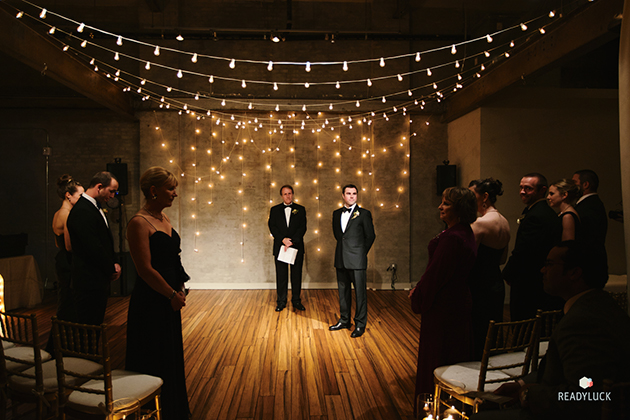
Photo: Lindsay Hite of Readyluck
They say practice makes perfect, and the same goes for your wedding ceremony. While you may have watched a few (and even stood up as a bridesmaid!), if you’ve never stood up at the altar before, it will still feel pretty new. And even if your wedding party is full of seasoned pros, a wedding or three a year does not an expert make. That’s where the rehearsal comes in! Rehearsing for your ceremony serves a few major purposes, from familiarizing everyone with the order they’ll process in and where they’ll stand to when readings and vows will take place. To really make the most of this important pre-wedding detail, we’ve turned to the experts at Kelly Karli Weddings & Events for five tips that will ensure your ceremony rehearsal is a smashing success.
Communicate With Your Officiant
“It’s always a good idea to review your ceremony with your officiant before the rehearsal begins,” says Taylor Walkowicz, creative director and lead planner. “Make sure he or she is comfortable with the order of things, review last-minute changes, and take a moment to cover any questions that might come up.” She recommends confirming who will be providing the copies of readings, who will have your vows, and who will be providing the necessary items for any rituals or unity ceremonies (as well as where they’ll go during the ceremony). “This can relieve a lot of last-minute panic on your wedding day!” Walkowicz explains.
Practice in Place
For maximum success, rehearse at the actual venue where you’ll be holding the ceremony so everyone gets comfortable in the space and can figure out exactly where they’ll need to go the next day. Not possible? “Bring a photo of the ceremony site with you so your bridal party can visualize where they’ll be on your wedding day,” says associate planner Lindsey Will. “It might seem like a no-brainer to you (since you’ve been in your ceremony space a few times before), but being able to see what the space looks like will really help those who haven’t seen the ceremony site before.”
Print Copies
Instead of just telling people where to go and when they’ll need to move or speak, print out copies of the processional order, a diagram of the standing order, an overview of the order of the ceremony, and seating placement for your family and friends. Says Walkowicz, “Share these with the ushers, too! If you have specific seats reserved for family or friends, this will let them know where to escort people the next day.” Your wedding party will also be able to review their place and get a better sense of what happens when, even if the rehearsal itself goes by in a blur.
See more: Who Needs to Be at the Ceremony Rehearsal?
Bring Your Wedding Party Timeline
Your rehearsal is about more than just practicing your ceremony: It’s a great chance to get everyone ready for how things will go throughout the day. “Creating a timeline for your wedding party, family, and friends is a great way to ensure they’re all on the same page,” explains Will. Include your hair and makeup schedule, a meeting time and place for the groomsmen, exactly when your wedding party will need to depart for (and arrive at!) the ceremony site, specifics about transportation, and a general timeline of when you’ll be taking photos. “Distribute the timeline at the rehearsal and set aside a few minutes to review it and answer any questions your family and wedding party might have, so you can relax the next day,” Will says.
Take Your Time!
While you may want to rush through the rehearsal to get to the rehearsal dinner, spend a little extra time communicating with every single person who is participating in the ceremony to make sure they’re comfortable with the schedule of events. “Your wedding party, ushers, readers, flower girls, ring bearers, and family will all have different and unique questions about their responsibilities, so give yourself plenty of time to speak with each of them and address any concerns,” says Walkowicz. “Schedule at least an hour for the rehearsal. The actual processional, ceremony order, and recessional might only take 20 or 30 minutes, but leave extra time for questions and to iron out any details that made more sense on paper than they do when you’re actually practicing.”
